Overall
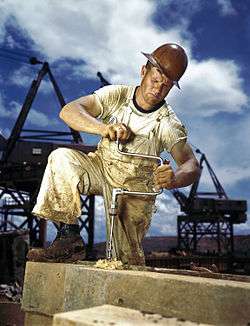
An overall, also called overalls, bib-and-brace overalls, or dungarees, is a type of garment which is usually used as protective clothing when working. The garment is sometimes referred to as a "pair of overalls" by analogy with "pair of trousers".[1]
Overalls were originally made of denim, but they can also be made of corduroy or chino cloth. Overalls were invented in the 1890s by Levi Strauss and Jacob Davis at Levi Strauss & Co., but they went through an evolution to reach their modern form.[2] Initially only used for protective clothing in work settings, they have become a garment of high fashion as "potential cult items".[3]
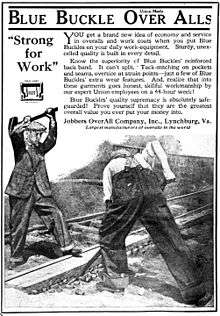
History
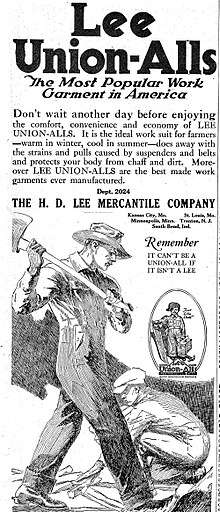
Beginnings
The exact beginnings of the wearing of overalls are unclear, but they are mentioned in literature as early as 1776 as a protective working garment commonly worn by slaves.[4]
The first evidence of overalls being mass-produced are those made by Levi Strauss and Jacob Davis in the 1890s. The first "jeans" they invented were actually overalls ("waist overalls" or "waist-high overalls"), consisting of suspenders attached to denim pants with buttons. There was no top part with a bib.[2] From the beginning, denim overalls were popular workers' garments due to their durability. In fact, Levi, Strauss & Co.'s slogan in the 1880s-1890s was "Never Rip, Never Tear."[5]
In 1911, Harry David Lee made the first bib overalls, made of pants with pockets sewn to a shirt with a bib and with straps over the shoulders.[2] This turned into the Lee Union-All in 1913. The Union-All consisted of dungarees sewn to a work shirt. It had many pockets, cuffed sleeves and legs, and a wide collar. It was very popular with workers, and was also worn by women and children.[2]
In 1927, Lee's developed a "hookless fastener" and created "buttonless" Union-Alls and overalls. Zippers replaced buttons.[2] Soon after, Suspender buttons were traded in for belt loops to attach over-the-shoulder straps.[2]
World War I
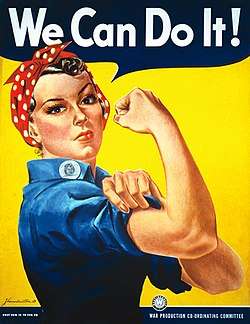
American soldiers in World War I wore Lee's Union-Alls starting in 1917. They were chosen by the government because they were durable.[2] The military also supplied the mechanic and supply units with Union-Alls.[5]
The Great Depression
In the 1930s, the poorest segments of the American population wore overalls: farmers, miners, loggers, and railroad workers.[6] They were most commonly worn by men and boys in the Southern United States and the Midwestern United States. They can be seen in many of Walker Evans's photographs.[5]
Bib overalls (in different colors and textiles) have become a popular garment among American youth, from the 1960s onward.[7]
World War II
During World War II, women assumed men's factory jobs since the men were off at war. Their loose-fitting clothes were deemed dangerous in factory conditions, leading to women adopting men's work clothing. This was controversial, though, since many men were still uncomfortable with the idea of women wearing pants, and especially with them wearing overalls in public, outside of the factory. A commonly recognized image featuring overalls (more specifically, Union-Alls) is that of Rosie the Riveter, from a 1943 poster used to boost workers' morale.[5]
Feminist movement
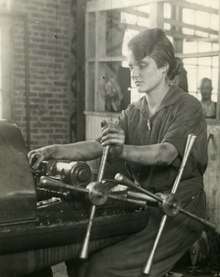
At a time when women wearing trousers was largely viewed as unacceptable, overalls were more widely accepted as garments for young children in the 1890s.[8] They were readymade and could be purchased by mail-order catalogues. Overalls were worn for play by boys and girls, made of denim or some other durable fabric. Like overalls for adults, they were used as a protective layer against nicer clothes underneath. They also allowed for greater mobility. Still, overalls were not widely worn by adult women until the late 1960s.[8]
Overalls were often worn at, and are seen as a symbol of, feminist protests of the 1970s.[9] They were intended as an anti-female-fashion, since overalls are not form-fitting like many other female garments. Overalls allowed women freedom of movement, and they did not have to wear a bra underneath. They reference the overalls worn by women workers during World War I and World War II. Since overalls were considered to be male garments for most of their existence, women adopted them to portray a message that they have equal authority to men.[9]
21st century

In the 21st century, overalls have evolved into a high fashion garment. Designers such as Stella McCartney feature them in ready-to-wear collections for women and children. Stella McCartney's children's overalls sell for as much as $138.[10] Nordstrom sells overalls for as much as $1,080.[11]
Brands
Lee's and Levi, Strauss & Co. were not the only companies making overalls in the late 19th and 20th centuries.
- One of the oldest brands of overalls, OshKosh B'gosh, founded in 1895 in Wisconsin, specialized in hickory stripe (blue and white stripe) bib overalls. The company produced bib overalls for children in the late 1960s.[6]
- Larned, Carter & Co., a company from Detroit, called themselves the "World's Greatest Overall Makers." They marketed their products as uniforms for railroad workers.[4]
- One of the biggest overall manufacturers was Blue Bell, which began in North Carolina in 1904. It was popular among railroad workers.[4]
- Jellico Clothing Manufacturing Co., later renamed Big Ben, was a major competitor of Blue Bell. Big Ben bought Blue Bell in 1926 and continued under the name Blue Bell.[4] Blue Bell then bought the overalls company Casey Jones.[4]
Garments adapted from the overall
Shortalls (a contraction of the words "short" and "overalls") are overalls adapted so the part of the garment below the waist is shorts.[12] They can be worn by toddlers, with "crotch and leg snaps to facilitate diaper changes."[7]
In skirtalls, the part of the garment below the waist is a skirt.[7] In capri overalls, the legs are capri pants.[7]
Salopettes is the French word for bib-and-brace overalls. The word is used in English for a similar garment to overalls worn for sailing, skiing, diving and other heavy duty activities. They are made of wind-and-waterproof trousers, traditionally with a high waist reaching to the chest and held up by adjustable shoulder braces.[13][14]
Historically, military "overalls" were loose garments worn in the 18th and early 19th centuries over soldiers' breeches and gaiters when on active service or in barracks. After 1823, the term was replaced by that of "trousers" in British Army documents, but it survives to the present day in reference to the tight-fitting garments strapped under the instep, worn as part of the mess dress and full dress uniforms of cavalry regiments.[15]
References
- ↑ "Walton & Taylor "The History of Overalls (Jeans)"". www.waltontaylor.com.
- 1 2 3 4 5 6 7 1973-, Kyi, Tanya Lloyd, (2011). The lowdown on denim. Hanmer, Clayton, 1978-. Toronto: Annick Press. ISBN 9781554514151. OCLC 825770364.
- ↑ "Christian Dior Fall 2017 Ready-to-Wear Collection - Vogue"". www.vogue.com.
- 1 2 3 4 5 7-, Sullivan, James, 1965 November (2006). Jeans : a cultural history of an American icon. New York: Gotham Books. ISBN 1592402143. OCLC 62697070.
- 1 2 3 4 Museum,, Fashion Institute of Technology (New York, N.Y.). Denim : fashion's frontier. McClendon, Emma,. New Haven. ISBN 9780300219142. OCLC 930798077.
- 1 2 Douglas., Gunn, (2012). Vintage menswear : a collection from the Vintage Showroom. Sims, Josh., Luckett, Roy., Vintage Showroom. London: Laurence King. ISBN 1780672039. OCLC 866622270.
- 1 2 3 4 "Overalls - Definition of an Overall from the Clothing Definitions Directory by Apparel Search". Retrieved November 25, 2017.
- 1 2 Paoletti, Jo Barraclough (2012). Pink and blue : telling the boys from the girls in America. Bloomington: Indiana University Press. ISBN 9780253001306. OCLC 775869179.
- 1 2 Things that liberate : an Australian feminist wunderkammer. Bartlett, Alison., Henderson, Margaret. Newcastle upon Tyne, U.K. ISBN 9781443867405. OCLC 891082123.
- ↑ "Stella McCartney - Designer RTW, Bags & accessories, Lingerie, Adidas by Stella McCartney, Fragrances, Kids". Stella McCartney - Designer RTW, Bags & accessories, Lingerie, Adidas by Stella McCartney, Fragrances, Kids (in us). Retrieved November 13, 2017.
- ↑ "Tu es mon TRÉSOR Imitation Pearl Embellished Overalls (Nordstrom Exclusive) | Nordstrom". Nordstrom. Retrieved November 13, 2017.
- ↑ Bryant, Margaret M. (1974). "Blends Are Increasing". American Speech. 49 (3/4): 163–184. doi:10.2307/3087796. JSTOR 3087796.
- ↑ "the definition of salopettes". Dictionary.com. Retrieved November 25, 2017.
- ↑ "Une histoire de salopette". La Parisienne (in French). May 24, 2010. Retrieved March 27, 2018.
- ↑ Carman, W.Y. A Dictionary of Military Uniform. p. 97. ISBN 0-684-15130-8.
External links
| Look up overall or shortalls in Wiktionary, the free dictionary. |